Addressing global warming requires utilization of every available tool to reduce carbon emissions and limit their impact on the climate. Deploying carbon capture and storage (CCS) while transitioning from fossil fuels to renewable energy is an essential strategy for achieving net-zero emissions and keeping the global temperature rise below 2°C above the levels before the Industrial Revolution—in accordance with the Paris Agreement.
To meet the ambitious target of the Paris Agreement, countries must scale up CCS deployment to store between 1.8 and 6 gigatonnes (Gt) of CO₂ annually, far exceeding the current capacity of only about 50 mtpa.
As a country highly dependent on oil and gas for economic growth, aligning with the Paris Agreement's goals poses a challenge, but it also presents opportunities. Despite contributing a relatively small share of global emissions (approximately 0.64 tonnes of CO2 per capita), Nigeria is one of the countries most vulnerable to the impacts of climate change, such as desertification and flooding.
Nigeria’s Nationally Determined Contributions (NDCs) under the Paris Agreement outline its commitment to reducing greenhouse-gas (GHG) emissions by 20% by 2030 compared to business-as-usual levels, focusing on:
- Transitioning toward renewable energy sources like solar and hydropower.
- Expanding the adoption of energy-efficient technologies.
- Reducing gas flaring in the oil industry.
- Promoting afforestation and sustainable land-use practices.
Incorporating CCS is increasingly seen as a key component of Nigeria's strategy to meet its emissions-reduction targets. As conceptualized in Fig. 1, the CCS value chain involves four major activities: capturing CO2 from a point source, compressing it for easy transportation, transporting the compressed CO2 via pipelines or shipping to a storage location, and injecting into the subsurface for permanent storage in suitable geologic formations.
Given Nigeria's geological potential for CO2 storage, especially in the Niger Delta region, CCS offers a viable solution to balance economic reliance on fossil fuels while mitigating the environmental impact.
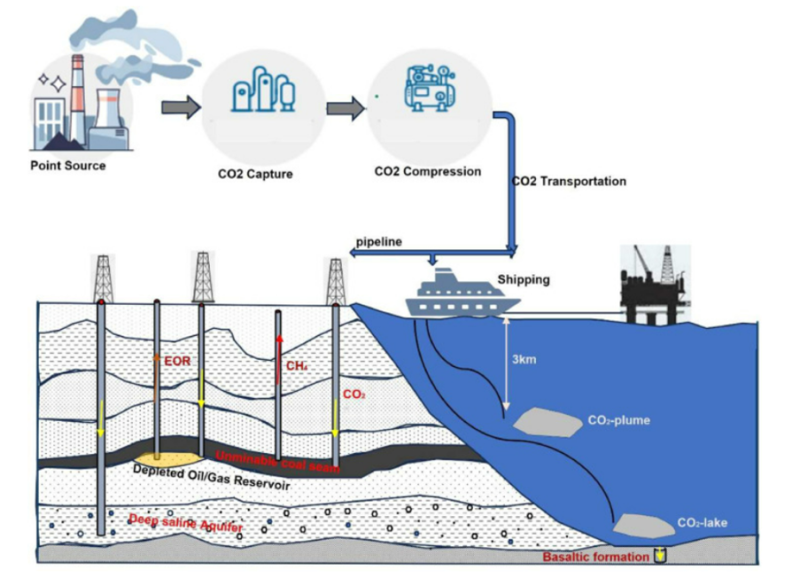
This article assesses Nigeria's readiness for CCS and the associated opportunities for emissions reduction. It provides an overview of recent developments in the CCS sector, with a focus on policy and regulatory advancements and geological assessments for CO2 storage potential.
Nigeria’s Energy Industry and Emissions
Nigeria’s primary energy mix is significantly met by fossil fuels, with about 80% of the country’s electricity being generated from these sources (Fig. 2). The country boasts a total oil reserve of approximately 37 billion bbl and produces around 1.4 million BPD. In terms of natural gas, Nigeria has reserves of about 5.9 trillion m3, averagely producing 220 million m3 daily. The demand for natural gas stood at around 18.7 billion m3 in 2023. Nationwide fuel demand is expected to increase significantly, with projections for natural gas consumption growth rate at 16.6% annually by 2030, thus posing a substantial increase in carbon emissions.
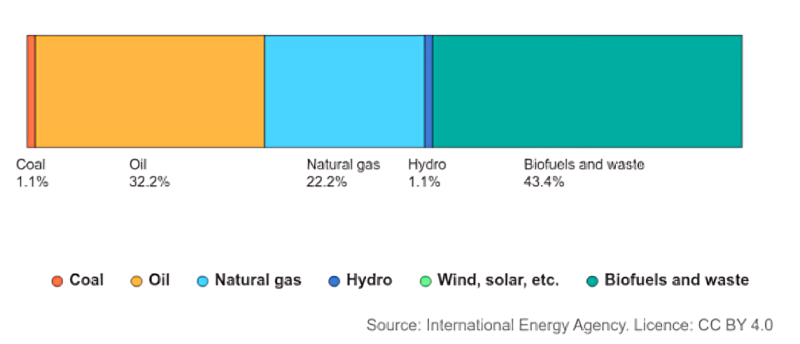
As shown in Fig. 3, emissions from the oil and gas sector stand at 208.61 MtCO2e, accounting for around 55% of the country’s total GHG emissions. Given this anticipated increase in emissions, proactive measures are essential to meet Nigeria’s NDC target of reducing emissions by 43 MtCO2e (20%) below 2018 levels by 2030, and up to 100 MtCO2e (47%) with international support in terms of finance, technology, and capacity.
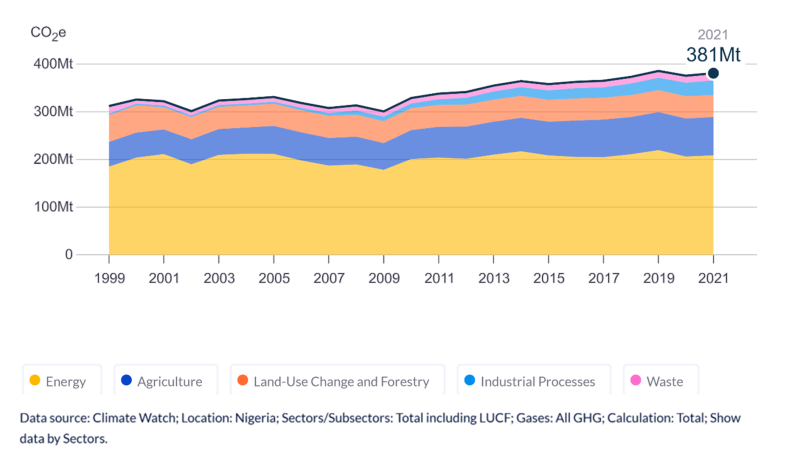
CCS Projects in Nigeria
Although the government has recognized the potential of CCS in its energy transition, there are no CCS projects currently operating in the country. But steps are being taken to set the groundwork for future CCS deployment. In 2023, the government partnered with World Bank/IFC to fund a diagnostic and scoping study focused on assessing Nigeria’s CO2 sources and storage potential (IEAGHG, 2023). The first phase of the project included national CO2 source and storage assessments, source-sink mapping, evaluation of regulation gaps, and stakeholder engagement.
The initiatives identified 15 potential CCS projects, with the top two projects identified as fertilizer and cement plants, located in proximity to the Niger Delta where offshore storage options are being explored. These projects are designed to capture 2.0 to 2.5 mtpa of CO2 and stored in depleted oil fields. Pilot versions of these projects at a smaller scale of 20 ktpa are also being considered with the aim to demonstrate CCUS feasibility in Nigeria, supporting capacity building and future scalability across Africa (IEAGHG, 2023).
Policy and Regulatory Frameworks Development
For any new technology to reach its pinnacle of maturity, it generally undergoes a three-stage development cycle. First, the technology begins its journey in research laboratories, where initial studies and experiments are conducted to assess its feasibility and potential—this marks the research and development stage.
Once the technology is proven feasible with a considerable degree of certainty, it enters the second stage—demonstration. At this point, the technology is implemented on a pilot scale to test its viability and performance in real-world conditions. This may involve strategies to reduce cost and the development of policies and regulatory frameworks to encourage its adoption and investment.
Lastly, the final stage is marked by large-scale deployment and commercialization of the technology, characterized by global adoption and integration with other technologies. Like any other technology, CCS is following this cycle and can be said to be transitioning from the pilot scale to the commercial deployment stage globally.
Creating an enabling environment for the implementation of CCS requires the enactment of relevant policies and regulatory frameworks. However, the absence of legislation governing CCS deployment has been a major hindrance for the technology to fully take off in many parts of the world, particularly in Africa, which lags behind technologically advanced continents like Europe and the Americas.
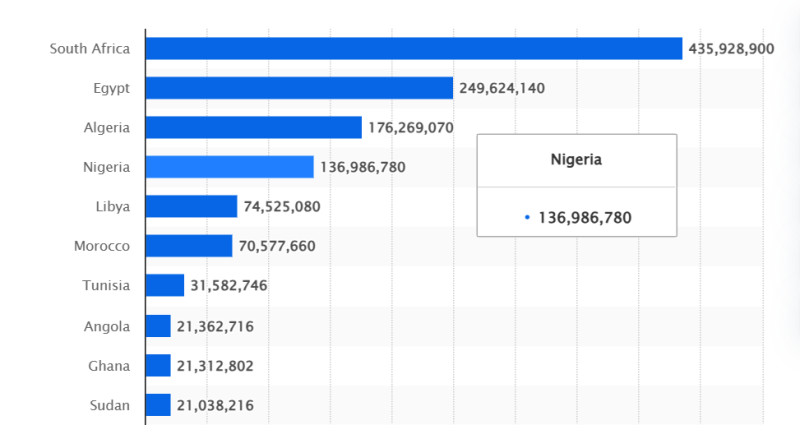
As the fourth-largest emitter and being amongst the first countries to enact relevant policies in Africa, Nigeria is leading the continent to achieve its climate goals. The Nigeria’s Climate Change Act 2021 provides the legal framework for CCS, establishing the National Council on Climate Change to serve as the apex climate regulator responsible for monitoring and ensuring compliance with the carbon emission reduction targets. In 2022, the Nigerian government introduced the Nigeria Energy Transition Plan (ETP), aiming to combat climate change and achieve net-zero emissions by 2060. To achieve this target, the ETP highlights the importance of deploying CCS in the oil industry—the sector producing the highest GHG emissions.
Prior to the enactment of the Climate Change Act in 2021, Nigeria had taken a leading role regionally, showcasing its position on climate change mitigation. The country is a signatory to the United Nations Framework Convention on Climate Change, the Paris Agreement, and the Kyoto Protocol, and it announced its commitment to achieve net-zero emissions by 2060 during COP26 in Glasgow.
Through the implementation of the Petroleum Industry Act (PIA) 2021, the Nigerian government set up the regulatory framework to attract private sector investment. As provisioned by the PIA, the Nigerian Upstream Petroleum Regulatory Commission (NUPRC), as the main regulatory body in the oil and gas industry, is responsible for the enactment and implementation of CO2 mitigation guidelines governing CCS deployment. The PIA considers CCS as a mitigation option for curbing CO2 emissions; therefore, it can be deployed legally within the country.
As highlighted above, effective policy and regulation are essential for the success of CCS. The International Energy Agency (IEA), a global advocate for CCS adoption, has put forward key elements that should be addressed in any regulatory framework. Authorization permits, ownership of storage site, liability management, requirements for monitoring, reporting, verification, and corrective and remediation measures are some of the issues identified. The NUPRC, in collaboration with other regulatory agencies such as the Ministry of Environment, should proactively facilitate these efforts by aligning national policies with internationally established standards.
While Nigeria has made some progress, developing a robust legal and regulatory framework will not only support the successful implementation of CCS but also promote socioeconomic development by creating new industries and "green" job opportunities.
Geological Storage Capacity Potential for CO2 in Nigeria
The geology of Nigeria is categorized into two terrains: the basement complex and the sedimentary basins, widespread across the nation (Fig. 5). There are six sedimentary basins, including the Benue Trough, Chad, Bida, Sokoto, Anambra, and Niger Delta.
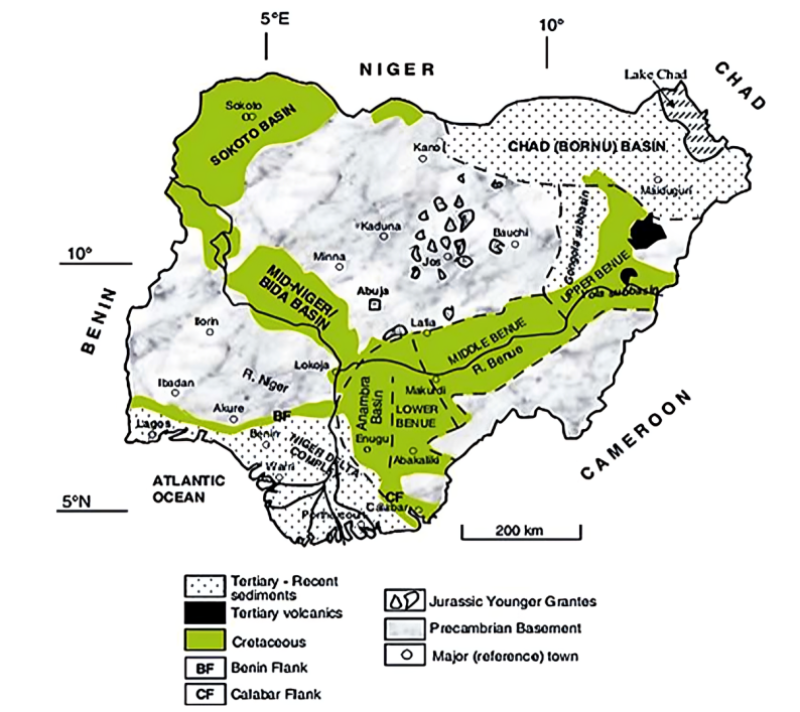
The Niger Delta Basin is the only basin that has been extensively explored due to the ongoing oil production activities and therefore can be regarded as the most suitable for CCS deployment (Umar et al., 2020). The basin is characterized by both depleted and producing oil and gas reservoirs. Having demonstrated the capacity to contain hydrocarbons over geological timescales, the formations are well-suited for secure, long-term CO2 storage. The presence of deep saline aquifers further enhances the basin’s storage potential, while impermeable caprocks and structural traps provide a natural seal, preventing the injected CO2 migrating out of the storage system.
Additionally, the basin’s existing infrastructure can be repurposed to support CCS operations, thereby reducing the capital investment needed for the development of new facilities. Another advantage of the Niger Delta over inland basins is its proximity to significant CO2-emitting industries, such as oil production facilities, refineries, gas processing plants, and other manufacturing industries, which can minimize transportation costs, making CCS more economically viable.
For effective containment, it is important to assess the feasibility of any potential basin based on a range of evaluation criteria. These standards have been established to determine whether the technology can be deployed in a manner that is reliable, safe, environmentally sustainable, and economically viable. Key factors to consider include geological conditions, geological hazards, hydrodynamic properties, basin maturity, and economic, societal, and environmental considerations (Aminu et al., 2021). Beyond technical feasibility, these evaluation criteria provide a clear framework for understanding risks, costs, and investment decisions.
Geologically, the Niger Delta basin is formed from the closing of the triple-junction rift-system caused by the separation of the African and South American plates, covering an area of about 300,000 km2 with sediment thickness reaching up to 12 km (Obaje, 2009; Umar et al., 2020).
As illustrated in Fig. 6, the basin generally exhibits an upward stratigraphic successions comprising the Akata, Agbada, and Benin Formations. The Akata Formation, which underlies the basin’s sequences, consists of marine shale with intercalations of sandstone and siltstone. Its thickness ranges from 600 to 6000 m and forms the hydrocarbon source rock of the basin (Umar et al., 2020).
Overlying the Akata Formation is the Agbada Formation, composed of deltaic sandstone with alternating shale units. The thickness of this unit varies across the basin, with some areas reaching up to 3940 m. This unit forms the important reservoir rocks, caprocks, and traps for the petroleum system.
The Benin Formation is the youngest of the three successions and is mainly composed of coarse-grained sandstone units capping the stratigraphic sequence of the basin. The deeper sections of the Benin Formation form some of the important saline aquifers in the region.
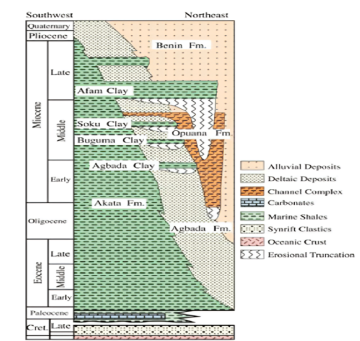
In terms of petrophysical properties, Umar et al. (2020) reported a 40% porosity for the Agbada reservoir unit and permeability of up to 2 darcy, as well as an average reservoir thickness of 100 m—all of which are favorable parameters for CO2 sequestration.
Although the potential for CCS in the Niger Delta has not been extensively investigated, the limited studies carried out reveal the possibility for long-term CO2 storage. A field scale assessment conducted on two oil fields by Umar et al. (2020) found the presence of outstanding reservoir-seal pair, huge basin size, suitable reservoir depth, moderate faulting intensity, and other favorable parameters making the basin well-suited for CCS. Insights from the 3D seismic volumes and well data also reveal the key geological parameters feasible for CO2 storage: possible reservoir units, potential caprock, and sealing structures. A further study carried out on the "HAN" field in the Niger Delta Basin confirmed its suitability for CCS with good injectivity values and an estimated capacity to store about 50 Mt of CO2. A separate field characterization by Ojo and Tse (2016) reported a theoretical CO2 storage capacity of around 147 Mt, positioning the basin as a potential CCS hub.
It is important to note that the findings from these studies highlight Nigeria’s enormous geological storage capacity for CO2, demonstrating the feasibility of leveraging the country's existing oil and gas infrastructure to support the implementation of CCS.
Nigeria’s CCS Readiness and Opportunities
The CCS Readiness Index (CCS-RI) is an evaluation criteria set by the Global CCS Institute to assess the readiness of countries for full-scale commercial CCS deployment. Using this approach, countries are evaluated based on certain criteria, which have been grouped under the following key indicators:
- Country’s inherent interest in CCS
- Development of relevant policies
- Legal and regulatory frameworks
- Development of geological CO2 storage assessment
Internationally, countries are ranked according to their levels of achievement in reducing barriers to CCS deployment. Nations ranking high in the first category are Australia, Norway, the UK, and the US. They have established supportive policy frameworks, developed relevant legal and regulatory frameworks, and conducted detailed storage assessments. Their progress reflects a high degree of readiness to implement large-scale CCS projects. However, despite these advancements, the current pace of global CCS implementation remains insufficient to meet the net-zero target.
CCS is particularly critical for countries heavily dependent on fossil fuels, such as China, Canada, and the US, as they seek to balance economic stability with emission-reduction commitments. These nations score highly on the CCS Interest (CCS-CI) Index, which assesses economic dependence on fossil fuels. Although many countries with high fossil fuel reliance have recorded slow progress in developing the necessary CCS readiness frameworks, as reflected in their low CCS-RI scores, Nigeria’s score hasn’t been published—perhaps because of gaps in the aforementioned indicators.
On this account, Nigeria would likely score slightly low on the CCS-RI evaluation compared to countries that have already developed substantial CCS frameworks. This lack of preparation puts the country at significant risk of economic disruption as global pressure to reduce emissions intensifies. Without accelerated policy and regulatory development, Nigeria, like other oil- dependent nations, will struggle to achieve its target for emission reductions with sustainable economic growth.
What Is the Way Forward?
Drawing upon the insights in this article, the following can be pursued for CCS implementation in Nigeria.
- Developing a robust regulatory framework for CCS is a shift from intention to action, maximizing the benefits of the entire CCS value chain, from capture and transport to storage and utilization.
- The government should develop a national strategy outlining Nigeria’s roadmap for CCS deployment.
- A cluster-based approach for CCS implementation should be adopted in the CCS roadmap for effective industrial decarbonization.
- As the main regulator in the industry, the NUPRC is entrusted with the responsibility to lead this effort, collaborating closely with industry stakeholders, government agencies, and research institutions.
For Further Reading
Geological Characterization of Depleted Oil and Gas Reservoirs for Carbon Sequestration Potentials in a Field in the Niger Delta, Nigeria, by A. Ojo, A. Tse, The University of Namibia.
A Review of Atmospheric Carbon Dioxide Sequestration Pathways; Processes and Current Status in Nigeria by O. Nwali, University of Ibadan; M. Oladunjoye, O. Alao, Obafemi Awolowo University
Depositional Patterns Across Syndepositional Normal Faults, Niger Delta, Nigeria by A. Owoyemi, Chevron Nigeria Ltd., B. Willis, Chevron
Reservoir Characterization and Modeling for CO2 Sequestration in ‘‘Han’’ Field, Onshore Niger Delta, Nigeria by S. Oyero, A. Olubola, Federal University of Technology; O. Ayinde, OlabisiOnabanjo University
Regional and Field Assessments of Potentials for Geological Storage of CO2: A Case Study of the Niger Delta Basin, Nigeria by B. Umar, Energy Commission of Nigeria; R. Gholami, Curtain University; P. Nayak, Sabah Shell Petroleum Company Ltd., et. al.
Carbon Capture and Storage: What Role in Nigeria's Energy Future? By M. Aminu, M. Jato, F. Shinkafi, et. al. Journal of Mining and Geology.
Nigeria Climate Change Data, Climate Watch
CCS Legal and Regulatory Indicator (CCS-LRI), Global CCS Institute
Carbon Capture and Storage: Model Regulatory Framework, IEA
IFC Nigeria Dissemination Workshop on Industrial CCUS and a New Center of Excellence by T. Dixon, IEAGHG
Hydrocarbon Prospectivity Evaluation of ‘Honyx’ Field, Niger Delta by A. James, Federal University of Technology.
Nigeria’s First Nationally Determine Contribution 2021 Update, Federal Ministry of Environment, Abuja.
Geology and Mineral Resources of Nigeria by N.G. Obaje, 2009.


